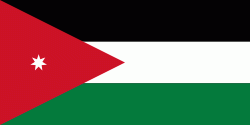Jordanian dinar
دا
The Jordanian dinar (دينار أردني; code: JOD; unofficially abbreviated as JD) has been the currency of Jordan since 1950. The dinar is divided into 10 dirhams, 100 qirsh (also called piastres) or 1000 fulus. It is pegged to the US dollar.The Central Bank of Jordan commenced operations in 1964 and became the sole issuer of Jordanian currency, in place of the Jordan Currency Board.
The Jordanian dinar is also widely used in the West Bank alongside the Israeli shekel.
In 1927, the British administration of the Palestinian Mandate established the Palestine Currency Board which issued the Palestine pound which was the official currency in both Mandatory Palestine and the Emirate of Transjordan. Though Jordan became an independent kingdom on 25 May 1946, it continued to use the Palestinian pound for a while. In 1949, it passed the Provisional Act No. 35 of 1949, which established the Jordan Currency Board as the sole authority in the kingdom entitled to issue Jordanian currency, called the Jordanian dinar. The Board was based in London and consisted of a president and four members, and began issuing Jordanian dinars in 1949 and was exchangeable for Palestinian pounds at parity.
After Jordan annexed the West Bank in April 1950, the dinar replaced the Palestinian pound. On 1 July 1950, the Jordanian dinar became the kingdom's official currency and legal tender. The use of the Palestine pound ceased in the country on 30 September 1950. The Central Bank of Jordan was established in 1959 and took over note production in 1964. In 1967, Jordan lost control of the West Bank, but the Jordanian dinar continued to be used there. It continues to be widely used in the West Bank alongside the Israeli shekel.
Country
-
Jordan
Jordan (الأردن, tr. ' ), officially the Hashemite Kingdom of Jordan''', is a country in Western Asia. It is situated at the crossroads of Asia, Africa, and Europe, within the Levant region, on the East Bank of the Jordan River. Jordan is bordered by Saudi Arabia to the south and east, Iraq to the northeast, Syria to the north, and the Palestinian West Bank, Israel, and the Dead Sea to the west. It has a 26 km coastline in its southwest on the Gulf of Aqaba's Red Sea, which separates Jordan from Egypt. Amman is Jordan's capital and largest city, as well as its economic, political, and cultural centre.
Modern-day Jordan has been inhabited by humans since the Paleolithic period. Three stable kingdoms emerged there at the end of the Bronze Age: Ammon, Moab and Edom. In the third century BC, the Arab Nabataeans established their Kingdom with Petra as the capital. Later rulers of the Transjordan region include the Assyrian, Babylonian, Roman, Byzantine, Rashidun, Umayyad, Abbasid, and the Ottoman empires. After the Great Arab Revolt against the Ottomans in 1916 during World War I, the Greater Syria region was partitioned by Britain and France. The Emirate of Transjordan was established in 1921 by the Hashemite, then Emir, Abdullah I, and the emirate became a British protectorate. In 1946, Jordan gained independence and became officially known in Arabic as the Hashemite Kingdom of Jordan. The country captured the West Bank during the 1948 Arab–Israeli War and annexed it until it was lost to Israel in 1967. Jordan renounced its claim to the territory in 1988, and became the second Arab state to sign a peace treaty with Israel in 1994.
